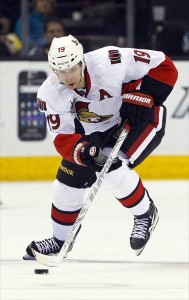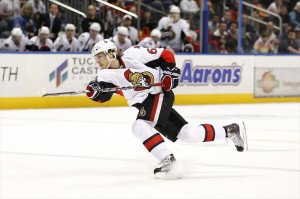
Having finished outside the playoffs there is clear need for improvement by the Ottawa Senators next season. While there is a reason why Paul MacLean is an NHL head coach and I am not, there is one key change that needs to be made to the Senators system along with other observations.
The first is reducing the number of shots against. Last season they ranked second last in the league, just behind their provincial rival in Toronto, allowing 34.7 shots against per game. In terms of the offensive side of the game they ranked fourth behind only the San Jose Sharks, New York Rangers and Chicago Blackhawks with 32.8 shots for per game.
Special team’s issues
Their special team’s play, while there is room for improvement it was good enough to leave them in the middle of the pack. They ranked 15th in the NHL with a combined special teams rating of 99.3%, which is adding power play and penalty kill percentages together.
This is something that Scotty Bowman used to review and his goal was to get to 100% or better. The top team last season was the Pittsburgh Penguins at 108% and the worst team was the Florida Panthers at 86%.
Last season Paul MacLean’s Senators had a negative goal differential between their power play and penalty killing time on ice. They had 50 power play goals for, 61 penalty kill goals against, 10 shorthanded goals against (26th overall) and five shorthanded goals for. This resulted in a negative 16 goal differential for their special teams.
http://youtu.be/0fuerU0MBRQ
As a total the Ottawa Senators scored 229 goals for and allowed 258 goals against for a negative 29 goal differential. Therefore on special teams they were minus 16 and at even strength they were minus 13. Both areas require improvement headed into next season.
Carry the puck
The question is how the Ottawa Senators go about changing this key issue. One key change that the Senators Head Coach Paul MacLean can make is a simple one. In short, carry the puck into the opponents end and use dump and chase very sparingly.
This past season @MannyElk tracked all zone entries at five on five play for the Ottawa Senators and you can see the results and find more details at NHL Numbers. Zone entries are relatively new to Hockey Analytics in large part due to the time and effort it takes to watch every game and track them.
Of late the CORSI band wagon has begun to overflow, however CORSI is not the be all and end all of Hockey Analytics, it is just the beginning. Paraphrasing a classic Spock quote from Star Trek, CORSI is the beginning of wisdom, not the end.
In all likelihood zone entries can be more indicative for current and future success. MannyElk’s data clearly shows that a controlled zone entry, moving into the attacking zone with puck possession, is exponentially better at generating shots than a dump and chase play.
Granted zone time for both types of entry can be equal, however teams that dump and chase likely spend the majority of their time trying to retrieve the puck. Teams that carry the puck across the blue line with possession have the chance to shoot on net.
Exhibit A – Jason Spezza

For example, Jason Spezza entered the offensive zone without possession 146 times last season. He generated 0.260 CORSI FOR (shots, missed shots, blocked shots) events per entry. That means out of every 10 times Spezza entered the offensive zone without control only 2.6 times would he generate a shot. While he entered the offensive zone with control 290 times and generated 0.741 CORSI FOR events per entry. That is a much better ratio of 7.4 shots per 10 entries.
What is interesting to note is that on his controlled zone entries he averaged 10.41 seconds on the attack per entry. While on his entries without control he averaged 10.48 seconds on the attack per entry. Clearly with a difference of 0.481 CORSI FOR events per zone entry, or nearly five shots per 10 entries, Spezza and his line mates exerted much of their energy trying to get the puck back in his dump ins.
There could be the argument that if they are spending the same or more time in the attacking zone on either choice of entry that is equal in terms of value. But it truly is not. Teams that bring the puck into the attacking zone will generate more scoring chances as opposed to a dump and chase team.
Of course this is only one season and one team worth of data, but to this point this relationship is very clear.
Best controlled zone entry Senators
When looking at the Ottawa Senators top players in term of percentage of zone entries with control it is not overly surprising who is on the list. Hemsky, Turris, Spezza, Ryan and MacArthur make up the top five. The only supposed top six forward with less than 50% controlled zone entries is Milan Michalek. While the worst forward is Chris Neil at just over 30%.

It is important to note that defensemen and forwards cannot be looked at equally with these statistics. Just by nature of the position defensemen tend to dump the puck in much more often than forwards. Although it is clear which defenders are better puck movers with Cowen, Gryba, Phillips and Methot all under 20% controlled entries. Naturally Erik Karlsson is the best defenseman at 44%, no surprise there.
The team as a whole is entering the offensive zone with control only 48% of the time. If they can bring that number up over 50% at five on five play that would go a long way in generating more scoring chances for the Ottawa Senators.
A takeaway for one of the team’s key free agents
With the NHL game placing more emphasis on speed and puck possession, having players that can carry the puck in and generate scoring chances is a big priority. With that in mind some of the Senators younger players were very good in this respect including Mike Hoffman (59%), Mika Zibanejad (57%) and Jean-Gabriel Pageau (53%).
In light of his decreased production and advancing age, perhaps letting Milan Michalek (46% controlled zone entries) leave might be the best course of action and give the younger players a chance to step in. A player like Mike Hoffman clearly impressed during his stint in the NHL, he could step in and take some of the minutes that were allotted to Michalek.
Of course it is a risk as we do not know if Hoffman can be productive over an 82 game season, but where the Senators currently stand in their mini-rebuilding phase I believe it is worth the chance.
Very special thanks to @MannyElk for making his data available for everyone to view.